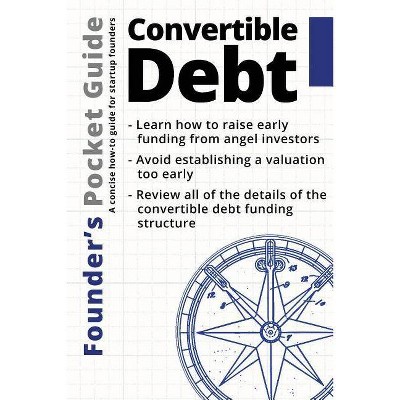Founder's Pocket Guide - by Stephen R Poland & Lisa A Bucki (Paperback)

Similar Products
Products of same category from the store
AllProduct info
<p/><br></br><p><b> Book Synopsis </b></p></br></br><p>This highly visual guide offers startup founders and employees a "nuts and bolts" view of how stock options and other forms of equity compensation work in early-stage startups.</p><p>Throughout this guide numerous mini-infographics illustrate the key concepts founders need to know and show the relationships between stock option grants, vesting timelines, exercise timing, and associated tax implications.</p><p>In detail, this Founder's Pocket Guide walks entrepreneurs though the following elements: </p><p><strong>Startup Equity Compensation Basics: Sharing Equity with Your Team</strong></p><p>The first section of this guide is structured to help founders build a base of understanding about the numerous definitions and terminology related to startup equity compensation and stock options. Topics covered include: </p><ul><li>A brief refresher on startup equity in preparation for delving into the details of stock options and other forms of equity compensation.</li><li>A quick review of how startup equity ownership is shared between the various stakeholder of a startup including the founders, investors, and employees.</li><li>The fundamental mechanics of how startup stock options work, including option grants, exercising, vesting, and selling of stock shares.</li><li>A detailed review of equity compensation terminology and definitions, such as vesting, strike price, fair market value, and spread.</li><li>An explanation of each of the most common types of equity compensation including Restricted Stock, Incentive Stock Options, Non-Qualified Stock Options, and Restricted Stock Units.</li></ul><p><strong>Equity Compensation Types in Detail</strong></p><p>The next section of this guide reviews each of the most common types of equity compensation, including detailed components such as tax implications, vesting and exercise parameters, and other IRS rules governing the ownership of each equity type. The following equity compensation types are covered: </p><ul><li>Restricted Stock (RS)</li><li>Incentive Stock Options (ISOs)</li><li>Early Exercise Incentive Stock Options (EE-ISOs)</li><li>Nonstatutory Stock Options (NSOs)</li><li>Early Exercise Nonstatutory Stock Options (EE-NSOs)</li><li>Restricted Stock Units (RSU)</li></ul><p><strong>Establishing Your Startup's Equity Plan</strong></p><p>In the final part of this guide we dig deeper into the key areas founders need to consider when developing an equity plan for their startup, with specific focus on the following issues: </p><ul><li>When to implement a formal equity incentive plan</li><li>What factors to consider when deciding how large the equity compensation pool should be</li><li>How to decide employee equity award amounts at the different stages of a startup's lifecycle</li><li>What general steps to take to establish a equity compensation plan for your startup</li><li>What key information that must be communicated to employees about equity compensation awards</li><li>Which step-by-step calculations are needed to truly understand equity ownership percentages and value</li><li>How IRS and SEC rules impact private company equity compensation</li></ul>
Price History
Price Archive shows prices from various stores, lets you see history and find the cheapest. There is no actual sale on the website. For all support, inquiry and suggestion messagescommunication@pricearchive.us




















